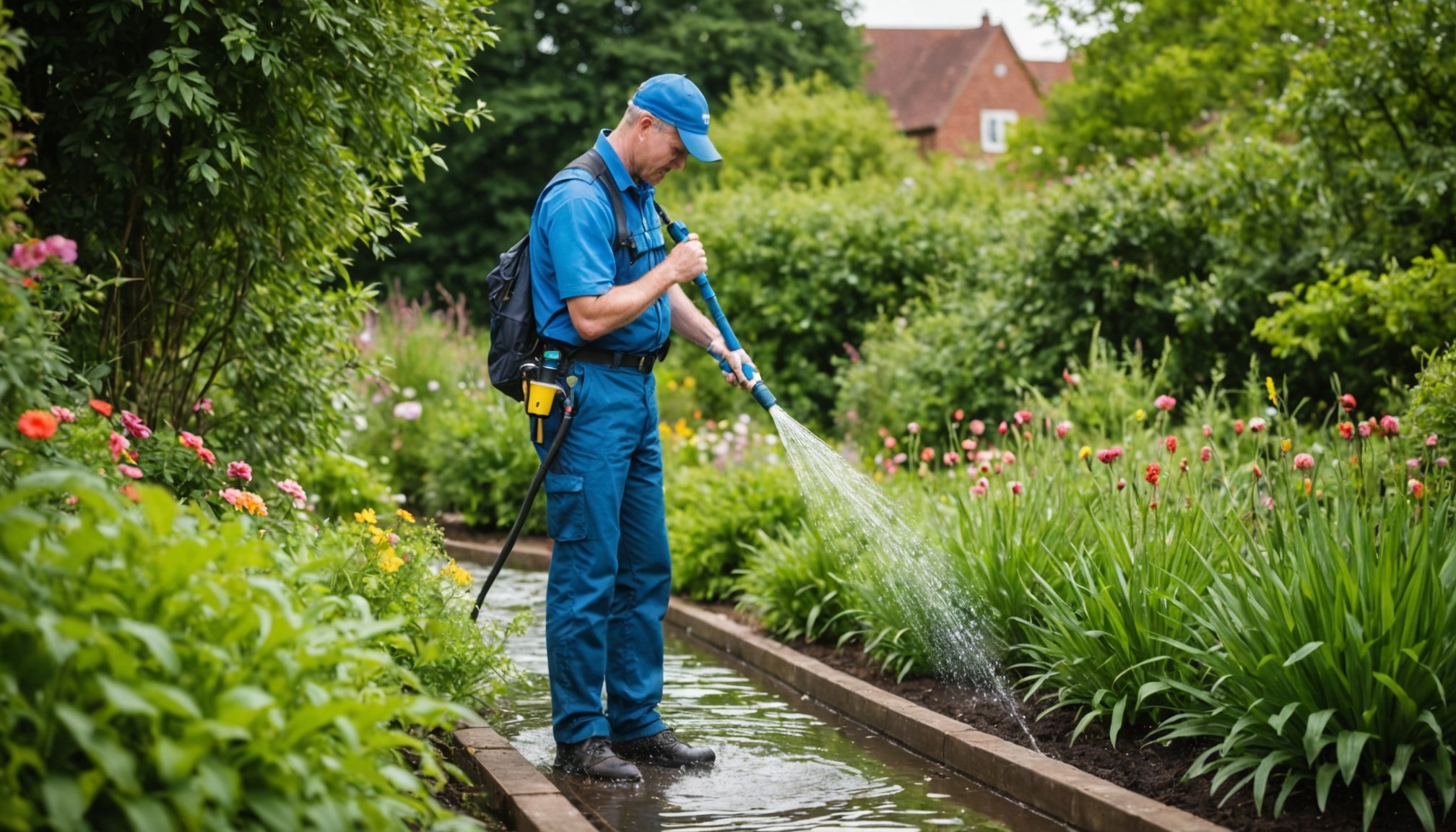Overview of the Hosepipe Ban in the UK
The hosepipe ban regulations in the UK are instituted primarily to manage water shortages, especially during prolonged dry spells. These drought conditions necessitate restrictions to conserve water and ensure that essential needs are met sustainably. Local water companies, who assess the severity of water shortages, enforce the bans.
Currently, UK garden watering laws vary depending on the region and the water authority involved. Typically, these laws prohibit the use of hosepipes for watering gardens, which helps to significantly reduce water consumption. It’s important to stay updated on specific regional guidelines, as fines can be imposed for non-compliance.
A lire en complément : Discover the Best Stylish and Child-Safe Stair Designs for UK Homes with Young Kids
The impact of these bans on gardening practices is notable. Gardeners often have to modify their techniques, opting for more water-efficient methods such as using watering cans and installing drip irrigation systems. The bans encourage the use of drought-resistant plants, which require less water and are more sustainable. Rainwater harvesting systems are also gaining popularity as they help mitigate reliance on regular water supply during dry periods. Understanding these adaptations is crucial for maintaining thriving gardens under such constraints.
Efficient Watering Techniques
Optimising garden watering is key to maintaining healthy plants while conserving resources. Understanding the best times to water can significantly improve moisture absorption. Early mornings or late evenings are ideal, as cooler temperatures reduce water loss through evaporation. This timing ensures that water reaches plant roots effectively.
Sujet a lire : Exploring Cutting-Edge Soundproofing Techniques for Urban Apartment Living in the UK
Employing targeted watering methods, such as drip irrigation, can enhance efficiency. This technique delivers water directly to the plant’s root zone, minimising evaporation and runoff. It allows precise control over the water amount each plant receives, which is beneficial in areas prone to drought.
When choosing between a watering can and a hose, consider the benefits of each tool. A watering can is more suited for small or delicate plants needing gentle watering. It provides precise control and minimises soil disturbance. Alternatively, a hose with a spray nozzle is effective for larger areas but can lead to overwatering if not used carefully.
Incorporating efficient watering methods and water conservation practices can significantly reduce water usage while maintaining a vibrant garden. Adjusting your approach based on plant needs and environmental conditions will result in a more sustainable and healthy garden ecosystem.
Alternative Methods for Irrigation
Water-efficient irrigation practices are essential for sustainable gardening. Implementing rainwater harvesting systems is an effective method to reduce dependence on municipal water supplies. By collecting precipitation from rooftops into barrels or tanks, gardeners can store natural rainfall to use during dry periods.
Another innovative approach is detailed exploration and application of greywater for garden irrigation. This involves the reuse of water from household activities, such as bathing and laundry, which, when properly treated, is safe for plant systems. Using greywater effectively can be a practical way to conserve water and reduce waste.
Additionally, soaker hoses offer an efficient solution for distributing moisture in garden beds. They are designed to deliver water directly to the plant’s base, minimizing evaporation and providing consistent moisture. This method offers several benefits:
- Reduces water usage compared to sprinklers.
- Targets the root zone more effectively.
- Minimizes weed growth as water is not broadcast over all areas.
These alternative methods enable gardeners to adopt sustainable practices, reducing wastage and maximising their water resources efficiently. With a focus on conserving this vital resource, gardeners can achieve lush and productive gardens while being environmentally responsible.
Drought-Resistant Plants
Drought-tolerant plants offer an excellent solution for gardeners looking to maintain vibrancy with minimal water usage. In the UK, several native species have adapted to thrive under dry conditions, contributing to a more resilient garden choice. Among these are the Common Yarrow (Achillea millefolium), Lavender (Lavandula), and Sea Holly (Eryngium), which are not only low-maintenance but add diverse textures and colours to any garden space.
Integrating drought-resistant varieties into existing gardens involves practical strategies. Start by identifying areas of the garden that receive the most sunlight and plant drought-tolerant species there. This maximises their natural ability to withstand dry spells. Another approach is grouping plants with similar water needs. This ensures efficient watering practices and supports a low-maintenance garden ecosystem.
Cultivating drought-tolerant plants has several benefits. These plants typically require less frequent watering, reducing overall water consumption and utility costs. Additionally, they are generally hardier and less susceptible to stress during dry periods, leading to a healthier garden environment. Embracing resilient garden choices can result in a sustainable, beautiful outdoor space that flourishes despite climate challenges.
Moisture Retention Strategies
When it comes to soil moisture retention, improving soil structure is often the cornerstone. One effective way to enhance this is by incorporating organic matter such as compost or well-rotted manure. These materials help improve the soil’s water-holding capacity by increasing pore space and improving the texture. In turn, this results in more efficient water usage, which is especially crucial in regions prone to drought.
Gardening tips for watering wisely revolve around timing and technique. Watering early in the morning or late in the evening minimizes evaporation, ensuring that more moisture reaches the plant roots. Additionally, delivering water directly to the base of plants rather than sprinkling can improve absorption and reduce waste.
Another excellent moisture retention strategy is mulching. Applying a layer of organic mulch, such as straw, wood chips, or grass clippings, not only reduces evaporation but also keeps the soil temperature stable. This practice can significantly conserve moisture by blocking direct sunlight and wind exposure.
Overall, the role of organic matter forms the backbone of effective moisture retention strategies. By following these practical techniques, gardeners can achieve healthier plants with less water dependency, thereby participating in sustainable gardening practices.
Understanding Regulations on Hosepipe Use
Gardening enthusiasts must stay updated on hosepipe legislation to avoid infractions. In the UK, both national and local hosepipe ban regulations can affect how and when you water your garden. National regulations are typically enforced during extensive drought conditions across large areas, while local authorities may impose bans based on more specific circumstances in their communities.
To ascertain the status of a hosepipe ban in your area, regularly check resources provided by local councils and water suppliers’ websites. Many offer online tools where you can input your postcode to receive updates on existing restrictions. It’s crucial to understand that violations of these bans can lead to penalties, including fines.
For gardeners, being aware of these UK gardening laws is essential. They not only dictate when you can use a hosepipe but also aim to ensure fair water usage among all residents during drought conditions. To promote efficiency and compliance, consider alternative methods like using watering cans or installing rainwater collection systems for garden care during restrictions. These solutions enable gardeners to maintain their green spaces without breaching hosepipe legislation, thus encouraging responsible gardening practices.
Real-Life Examples and Case Studies
In the face of hosepipe restrictions, many gardeners have turned challenges into opportunities. Let’s explore some successful transformations.
One garden in Southern England witnessed a spectacular change thanks to innovative strategies. Despite water limitations, the gardener implemented a drip irrigation system, maximising efficiency. By focusing on drought-resistant plants, they achieved a lush landscape throughout the season.
Community initiatives have also made a significant impact. A small town in Wales rallied together, creating a water conservation scheme aimed at promoting sustainable gardening. Through workshops, residents shared knowledge on effective water-saving techniques, like rainwater harvesting, which saw a drastic reduction in water usage.
Reflecting on personal experiences, users have shared numerous testimonials about their success stories. One user, Linda, detailed her journey of adopting a water-conscious gardening approach. By utilising mulch and conducting soil moisture tests, she maintained a thriving garden amidst restrictions. Linda’s experience emphasizes the practicality of simple adjustments leading to substantial savings.
These practical case studies illustrate not just individual achievement, but also a collective movement towards sustainable and successful gardening practices under challenging conditions. Embracing these strategies not only benefits gardens but also fosters a sense of community and responsibility towards environmental conservation.











